San Diego Opera’s sensual and thought provoking “Maria de Buenos Aires”
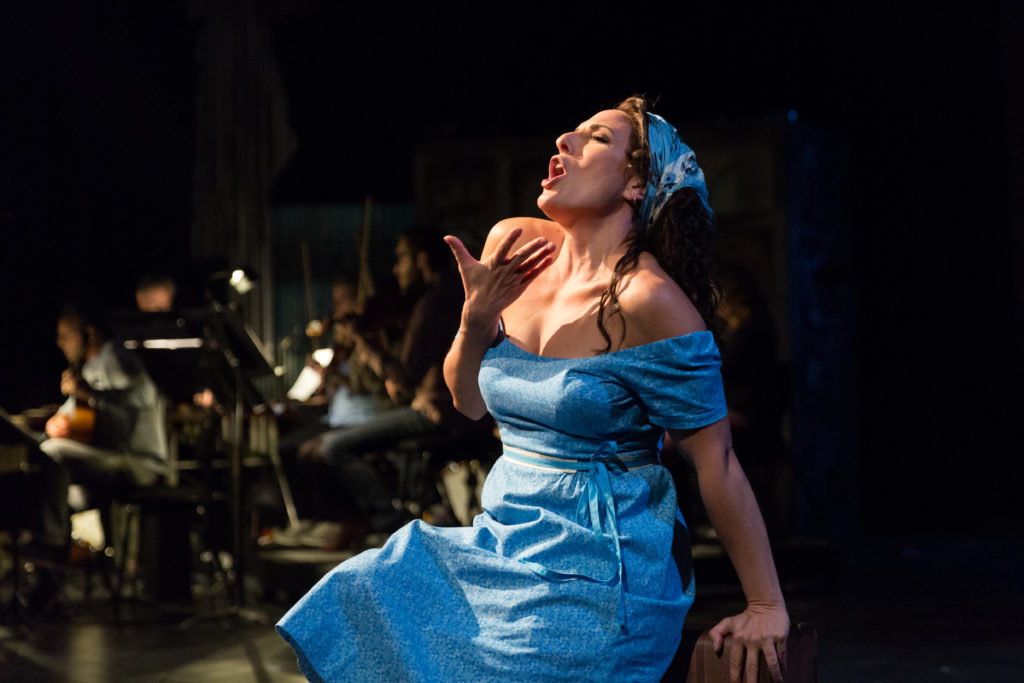
Mezzo-soprano Audrey Babcock is Maria in San Diego Opera’s MARIA DE BUENOS AIRES, January 2018. Photo by Karli Cadel.
San Diego Opera presents Astor Piazzolla’s Maria de Buenos Aires
Little Opera in 2 Parts for Orchestra, Narrator and Singers
Texts by Horacio Ferrer
Review by David Gregson, Friday, January 26
“Yo soy Maria de Buenos Aires / de Buenos Aires Maria ¿no ven quién soy yo?
Maria Tango, Maria del arrabal,
Maria noche, Maria pasión fatal,
Maria del amor de Buenos Aires soy yo.”
“I am Maria de Buenos Aires … Do you not see who I am?
Maria tango, slum Maria,
Maria night, Maria fatal passion,
Maria love of Buenos Aires, that’s me.”
As I wrote here at Opera West when I first saw this tango operita in Long Beach in January of 2012, “Maria is the tango. She is passion both profane and semi-divine. She is the history and heart and soul of Argentina. She is the sum of the immigrants whose cultural synthesis is symbolized in the tango. She is the subject that inspires and animates the poetry of Horacio Ferrer and lives vibrantly in tandem with the inventive and inspired music of Astor Piazzolla.”
San Diego Opera’s 2017-18 dētour Series production began Friday, January 26, and was slated for three more performances in the home of the San Diego Repertory Company, the Lyceum Theatre in Horton Plaza. The venue is a fine one and the whole show seemed highly polished on its opening.
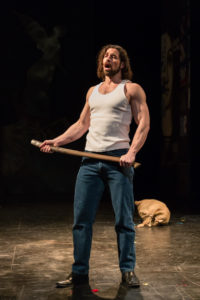
Baritone Paul La Rosa is El Payador in San Diego Opera’s MARIA DE BUENOS AIRES, January 2018. Photo by Karli Cadel.
John de los Santos’s staging was strikingly imaginative and included many visualizations of things absent in the published libretto. In fact, Santos provided a dramatic impetus missing in the texts themselves.
It would be difficult to improve upon the three principals — the eponymous Maria (sultry mezzo soprano Audrey Babcock), El Payador (warm toned “barihunk” Paul La Rosa), and El Duende (charismatic and protean actor/narrator Celeste Lanuza). Two male dancers, Laurence and Lester Gonzales, were elegant and exciting to watch in their tango duet.
Seated at the piano, conductor Bruce Stasyna deftly commanded a skilled ensemble of 11 players, with David Alsina playing the all-important bandoneon, an instrument that embodies Maria, the spirit of the tango and possibly Argentina itself — or so we are led to believe. So much surrounding the work of Astor Piazzolla has been hyped into a mythos that exudes “otherness” and challenges the naive outside world to fully comprehend it. The bandoneon has a mystical power, like the masks in Japanese Nōh drama.
Yet there is no denying the frontal seductive appeal of Piazzolla’s music. Although his maniupulation of traditional musical forms is ingenious and sophisticated, he communicates directly to the listener. His score ignites both passion and contemplation.
Encountering Maria for the first time involves so much arcana! The Performances magazine program tries to enlighten us. A payador is “a sort of gaucho minstrel,” Canyengue is a style of tango that “connotes roughness, sensuality and even rebelliousness,” a duende is a kind of goblin or sprite (good or bad) out of folklore, Lunfardo is a low-class dialect — and so on. We also need to be aware that the psychoanalysts that crop up in Scene 12 are explained by “the extraordinary density” of same in Buenos Aires. And, of course, we’d better go to Wikipedia to find out all we can about the Tango Nuevo. Lots to learn to get though the next hour and a half!
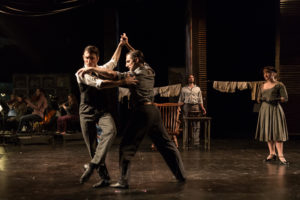
Dancers Lester and Laurence Gonzalez in San Diego Opera’s MARIA DE BUENOS AIRES, January 2018. Photo by Karli Cadel.
So, as a theatrical experience, Maria de Buenos Aires is simultaneously alluring and somewhat alienating. Horacio Ferrer’s surreal poetic texts are allusive and elusive and hard to process quickly — and when they are translated and projected as Supertitles, they are an almost fatal distraction. One looks to them for an elucidation of the spoken dialogue, but realizes time and time again that the poetry requires a world literature professor to provide exegesis. And there is so very much to read that — well, at a certain point one just gives up and regrets not having had a few more advanced Spanish lessons. Nothing we hear or read clearly explains the stage action. Best to ignore the titles altogther and just listen and watch. (SDO General Director David Bennett suggested as much in his pre-performance remarks.)
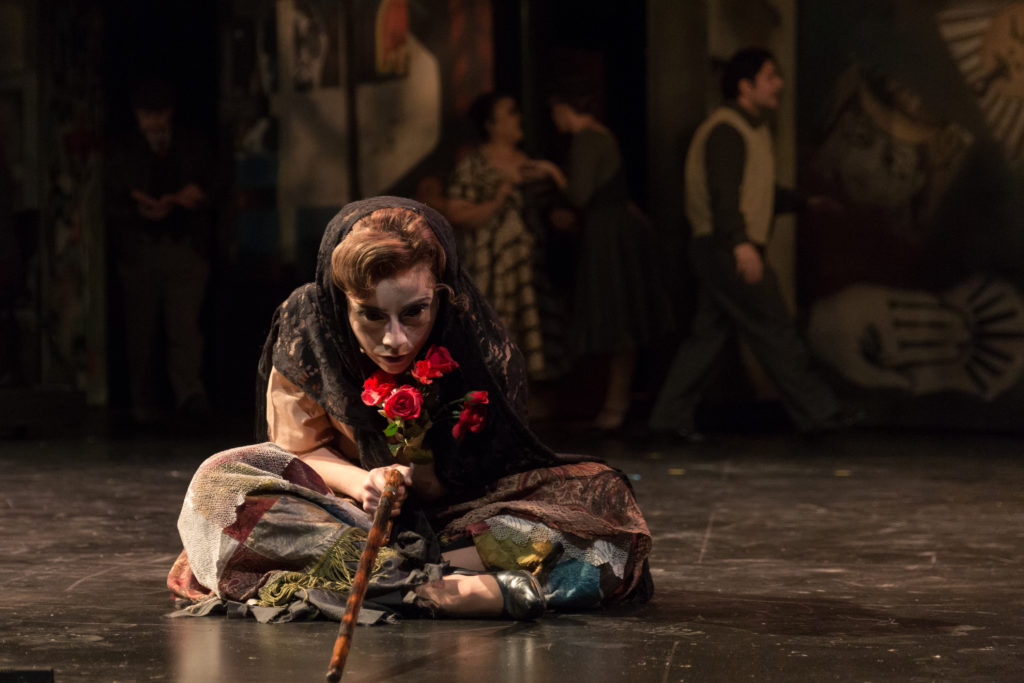
Actor Celeste Lanuza is El Duende in San Diego Opera’s MARIA DE BUENOS AIRES, January 2018. Photo by Karli Cadel.
This tango operita also defeats the likely expectations of one not already familiar with the work. There is not as much actual tango dancing as one might hope for, and it often seems as if spoken narration exceeds the amount of singing. It really goes without saying, the piece is not an opera but something virtually sui generis. The best classic operas have characters who sing and reveal their emotional states. Ferrer’s characters, such as they are, are abstractions that resist our attempt to relate to them.
Fortunately, all three featured performers were able to bring an exciting immediacy and specificity to their roles, no matter how obscure the meaning or vague the action. Babcock’s Maria became a real woman, a mesmerizing vocal and physical presence. La Rosa, both her lover and her guardian angel, simply commanded the stage with macho authority and suave vocal artistry. (Their voices did not appear to have been amplified.) As the mysterious narrator, Celeste Lanuza shifted shapes, playing a range of characters, from a clown to tispsy prelate. Her El Duende was both comical and demonic.
Everybody else in this episodic show was billed merely as “Ensemble,” but these performers provided a dazzling panoply of colorful Argentine types.
What’s it all about? Ferrer deals chiefly with a traditional literary idea of death and resurrection. A nation’s culture and art are bound together on this circular journey. Maria is murdered halfway through the piece and emerges as her own Shadow. At the end she gives birth to something. A new Maria? We are definitely in Joseph Campbell territory! Not to mention the works of Carl Jung, Sigmund Freud, or Sir James Frazer in The Golden Bough. Maria might inspire erudite college lectures on the sacred and the profane, and the Apollonian and Dionysian, the Shadow and the Self — but perhaps it’s best to succumb to Piazzolla’s charms without dwelling too much on such conundrums. Maria = Tango = Buenos Aires. That’s enough.
I have tried to credit almost everyone below.
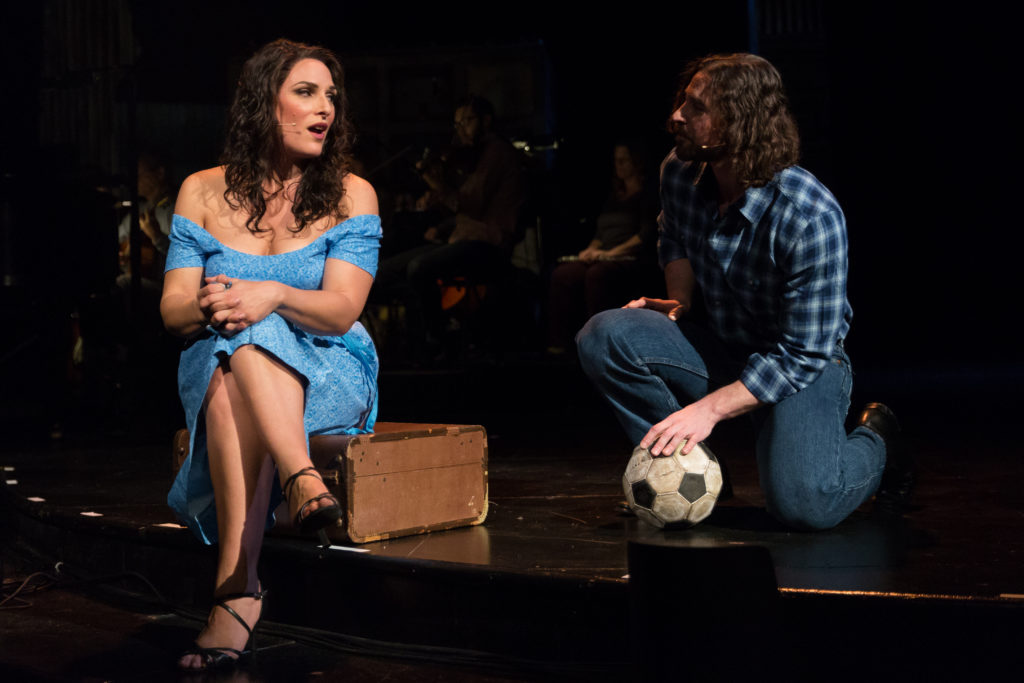
Mezzo-soprano Audrey Babcock (Maria) and baritone Paul La Rosa (El Payador) in San Diego Opera’s MARIA DE BUENOS AIRES, January 2018. Photo by Karli Cadel.
Cast
El Duende — Celeste Lanuza
Maria — Audrey Babcock
El Payador — Paul La Rosa
Ensemble — Serabeth Belon, Bernardo Bermudez,
Laura Bueno, Sandra Camarena,
Walter DuMelle, Rodolfo Ruiz-Velasco
John de los Santos — Stage Director
Bruce Stasyna — Conductor
Liliana Duque Piñeiro — Scenic Designer
Ingrid Helton — Costume Designer
Jason Bieber — Lighting Designer
Ross Goldman — Sound Design
Mary Yankee Peters — Production Stage Manager
Claudio Luchina, Ana Martinez — Supertitles
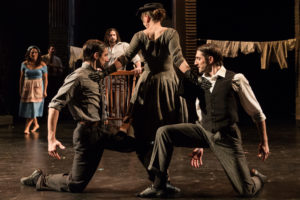
(L-R) Dancer Laurence Gonzalez, mezzo-soprano Laura Bueno (ensemble), and dancer Lester Gonzalez in San Diego MARIA DE BUENOS AIRES, January 2018. Photo by Karli Cadel.
San Diego Symphony
David Alsina — bandoneon
Wesley Precourt — violin 1
Alex Palamidis — violin 2
Nancy Lochner — viola
Chia-Ling Chien — cello
Margaret Johnston — bass
Sarah Tuck — flute
Jon Szanto, Benjamin Irons — percussion
Bruce Stasyna — piano
Fred Benedetti —guitar
Performances
FRI, JAN 26 AT 7PM
SAT, JAN 27 AT 7PM
SAT, JAN 27 AT 10
SUN, JAN 28 AT 2PM
Lyceum Theater
79 Horton Plaza 92101

Set Built by San Diego Opera scenic studio